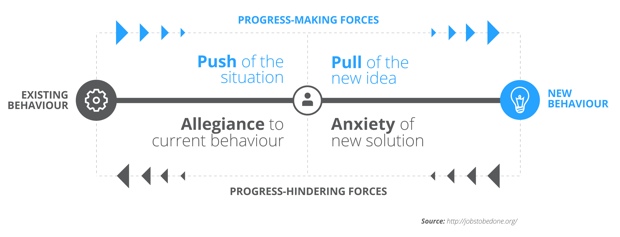The jobs-to-be-done framework isn’t new, but I’ve only recently started digging into it much more since it’s been gaining a lot of traction everywhere I look. For a nice primer on the topic see Eric Portelance’s recent article for Teehan+Lax called The Iceberg of Jobs-to-be-Done, in which he explains how crucial this framework is for good product design:
[Most successful products are created by] people who understand the importance of creating products that solve real customer problems, and have a set of tools and frameworks like jobs-to-be-done that they use to identify and validate the real human problems they’re trying to solve in the market.
The progress-making forces diagram has been particularly useful for me in client work, since it helps people understand how difficult it can be to change existing user behavior. I’m not a huge fan of the diagram on the JTBD site, so we made a new one:

The basic premise of the diagram is this. For someone to move from their existing behavior (a product they’re currently using) to new behavior (switching to a new product), there are two types of forces at work: progress-making forces, and progress-hindering forces.
Progress-making forces move people from their existing behavior to the new behavior, and consists of the push of the current situation (things they’re not happy with in the current product) and the pull of the new idea (things that sound appealing about the new product). Progress-hindering forces, on the other hand, hold people back from switching to new behavior. It consists of allegiance to the current behavior (things they really like about the current product) and the anxiety of the new solution (worries about learning curves and not being able to accomplish their goals with the new solution).
What this comes down to is that for someone to switch from an existing product to a new product, the progress-making forces have to be stronger than the progress-hindering forces. This might seem obvious, but applying this model to your product planning can inject an extremely healthy dose of reality. Is the product really that much better than a current solution? What does the new product have to do to overcome people’s allegiance to what they’re currently using?
In the context of product design this can be a crucial component to making a go/no-go decision on whether to go ahead with an idea, so it’s always a mental test I run with the teams when we’re working through our planning.